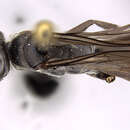Comprehensive Description
provided by Memoirs of the American Entomological Society
Anoplius (PompJlinus) insolens (Banks)
Pompiloides insolens Banks, 1912, Jour. N. Y. Ent. Soc, 19: 226 [Type: S, North Carolina: Black Mt., May (MCZ, no. 13, 681)].
Pompilinus insolens Dreisbach, 1949, Ent. Amer., (n.s.)29: 28, 33, 50.
Anoplius (Pompilinus) insolens Evans, 1951, Trans. Amer. Ent. Soc, 76: 304306. — Evans, 1956, Ann. Ent. Soc. Amer., 49: 176 (Mexico).
Female. — Length 7.5-14 mm. Black; pubescence wholly dark, somewhat bluish or violaceous. Body with considerably less hair than in the preceding species; propodeum always with a few very short, fine hairs on the sides. Clypeus about 2.5 X as broad as high, truncate or slightly concave below. Head slightly wider than high, TFD not more than about 1.12 X VFD; vertex straight across between eye-tops or arched very weakly. Front broad, MID .56-. 61 X TFD, averaging about .58; UID .80-.92 X LID; POL equal to or slightly greater than OOL. Third antennal segment slightly longer than one and two together, equal to from .68 to .84 X UID. Posterior margin of pronotum subangulate, not forming a clearly defined angle on the median line as, for example, in estellina. Front basitarsus with three comb-spines, the spines very short, not longer than the width of the tarsus.
Male. — Length 6.5-11 mm. Black; pubescence of variable coloration, often silvery over a considerable part of the head and thorax. Body mostly smooth and without erect hairs, the propodeum without hairs or with a few very short ones. Clypeus twice as broad as high; MID .58-. 63 X TFD; UID equal to or very slightly exceeding LID; POL usually slightly exceeding OOL; third antennal segment 2.4-3.0 X as long as wide, about as long as fourth segment. Venter smooth, with only scattered, short hairs. SGP also rather smooth, the median line not distinctly elevated, the apex obtusely angulate. Genitalia with the parameres gradually expanded nearly to the apex, which is subtruncate, the inner margin with a series of strong setae on the outer half; digiti rather slender, with delicate setae which are angled at their apices, ex
# Anopiius (Pompilinus) insolens (Bonks)
(also transcontinental in U.S.) A Anopiius (Anopiius) simulans (Cresson)
cept with some much stronger setae on the upper, outer side; aedoeagus parallelsided, angularly expanded at the apex (see fig. 95 in Evans, 1951, also fig. 43 in Dreisbach, 1949).
Distribution. — This species occurs transcontinentally in temperate North America, north to British Columbia, Ontario, and Maine, south to Georgia, Texas, the Mexican central plateau to the high parts of Veracruz and Morelos, and to California. (Map 57.)
Mexican specimens examined. — 21 29,4 8 6. Chihuahua: 2 5 5, Santa Clara, 2 July 1947 (WG) [AMNH]; 1 5 , 16 mi. SE Chihuahua, 11 July [AMNH]; 2 5 5 , 82 mi. S Juarez, 4000 feet, 15 Aug. 1957 (HAS) [OSU]; 1 5, Guzman, 4400 feet, Aug. 1906 (P. P. Calvert) [ANSP]; 1 5 , 10 mi. S Villa Ahumada, 4 July 1954 (E. I. Schlinger) [CIS]. Sonora: 1 5, Guaymas, 10 April (L. O. Howard) [USNM]. Durango: 1 2 , 8 mi. S Canutillo, 9 Aug. 1951 (HEE) [MCZ]. Zacatecas: 1 5,15 km. E Sombrerete, 7300 feet, 28-31 July 1951 (PDH) [CIS]. Aguascalientes: 1 2, Aguascalientes, 26 June 1952 (EG & CM) [CIS]. Michoacan: 1 5,1 $, 10 km. W Zitacuaro, 8000 feet, 11 July 1951 (HEE) [MCZ]. Morelos: 8 5 2,3 8 8 , 3 mi. NW Cuernavaca, 6500 feet, MayJune 1959 (HEE) [CU, MCZ]. Veracruz: 1 2 , 5 mi. E Acultzingo, 5000 feet, 9 June 1959 (HEE) [MCZ].
- bibliographic citation
- Evans, H.E. 1966. A Revision of the Mexican and Central American Spider Wasps of the Subfamily Pompilinae (Hymenoptera: Pompilidae). Memoirs of the American Entomological Society vol. 20. Philadelphia, USA

